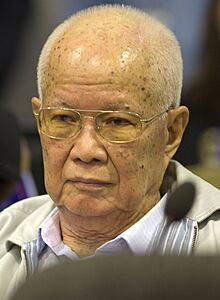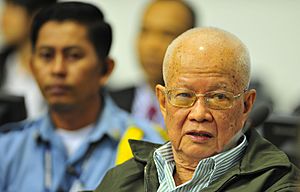Khieu Samphan facts for kids
Quick facts for kids
Khieu Samphan
|
|
|---|---|
| ខៀវ សំផន | |

Samphan in 2014
|
|
| Head of the Provisional government | |
| In office 1994–1998 |
|
| Leader of Cambodian National Unity Party | |
| In office 1992–1997 |
|
| Preceded by | Office established |
| Succeeded by | Himself (as Leader of KNSP) |
| General Secretary of PDK | |
| In office 1985–1993 |
|
| Preceded by | Pol Pot |
| Succeeded by | Himself (as leader of CNUP) |
| Chairman of the State Presidium | |
| In office 11 April 1976 – 7 January 1979 |
|
| Prime Minister | Pol Pot |
| Deputy | So Phim Nhim Ros |
| Leader | Pol Pot (General Secretary) |
| Preceded by | Norodom Sihanouk as President of the State Presidium |
| Succeeded by | Heng Samrin as Chairman of the People's Revolutionary Council |
| Prime Minister of Democratic Kampuchea | |
| Acting 4 April 1976 – 14 April 1976 |
|
| President | Norodom Sihanouk |
| Leader | Pol Pot (General Secretary) |
| Preceded by | Penn Nouth |
| Succeeded by | Pol Pot |
| Vice Prime minister and Minister of Defense of the Royal Government of National Union of Kampuchea | |
| In office 5 May 1970 – 14 July 1975 |
|
| Personal details | |
| Born | 28 July 1931 Romduol, Svay Rieng, Cambodia, French Indochina |
| Political party |
|
| Spouse | So Socheat |
| Alma mater | University of Montpellier (B.Ec) University of Paris (PhD, Econ.) |
| Conviction(s) |
|
| Criminal penalty | Life imprisonment (2014) |
Khieu Samphan (Khmer: ខៀវ សំផន; born 28 July 1931) is a Cambodian former political leader and economist. He was the chairman of the state presidium of Democratic Kampuchea (Cambodia) from 1976 to 1979. In this role, he was Cambodia's head of state and a very powerful official in the Khmer Rouge movement. However, Pol Pot was the highest leader in the party.
Before joining the Khmer Rouge, he was part of Prince Sihanouk's government. After a rebellion in 1967, Samphan went into hiding. He reappeared when the Khmer Rouge took control in 1975. In 2014, he was found guilty of serious crimes against many people and sentenced to prison for life. In 2018, he was also found guilty of crimes against a group of people. He is the oldest living former prime minister and the last senior member of the Khmer Rouge still alive.
Contents
Early Life and Education
Khieu Samphan was born in Svay Rieng Province, Cambodia. His father was a judge, and his mother sold fruits and vegetables. Samphan had a mix of Khmer and Chinese heritage from his family.
Even though his family faced difficulties, Samphan was a bright student. He earned a place at a good school, Lycée Sisowath. Later, he traveled to France to study economics at the University of Montpellier. He then earned a PhD in economics from the University of Paris.
Becoming a Political Thinker
In the 1950s, while studying in Paris, Samphan joined a group of Cambodian students who had new ideas about politics. He wrote his doctoral paper in 1959 about Cambodia's economy. In it, he suggested that Cambodia should rely on itself for development. He believed that rich countries were sometimes responsible for the poverty in poorer nations.
Samphan helped start the Khmer Students' Association. This group later led to the revolutionary movements that changed Cambodia in the 1970s, including the Khmer Rouge. When the French authorities closed this association, he started another student group called the Khmer Students' Union.
Early Political Career
After returning from Paris in 1959, Samphan taught law at the University of Phnom Penh. He also started a French-language newspaper called L'Observateur. This newspaper shared his political ideas, which the government did not like.
The government banned L'Observateur the next year. Police even publicly embarrassed Samphan. Despite this, Prince Norodom Sihanouk invited Samphan to join his political movement, Sangkum. This was the only political party in Cambodia at the time.
Samphan was elected as a representative for Sangkum in 1962, 1964, and 1966. He was known as a humble person who did not seek luxury, even when he was a minister. In 1966, he joined a special group created by Prince Sihanouk to keep other political groups in check. However, Samphan's strong political views caused problems, and he had to hide in the jungle to avoid arrest. Some people even thought he had been killed.
Joining the Khmer Rouge
In 1970, the National Assembly removed Prince Sihanouk as head of state, and the Khmer Republic was formed. The Khmer Rouge, including Samphan, then joined forces with Prince Sihanouk. They created a group called the National United Front of Kampuchea (FUNK) and a government called the Royal Government of the National Union of Kampuchea (GRUNK).
In this new alliance, Samphan became a deputy prime minister and minister of defense. He was also the commander of the GRUNK military. FUNK defeated the Khmer Republic in April 1975 and took control of all of Cambodia.
Role in Democratic Kampuchea
During the years of Democratic Kampuchea (1975–1979), Khieu Samphan remained a top leader. In 1976, he became the president of the central presidium. He stayed loyal to Pol Pot, which helped him survive when other leaders were removed from power. His important roles showed that he was a key figure in the ruling group.
In 1985, he officially took over from Pol Pot as the leader of the Khmer Rouge. He held this position until 1998. In December 1998, Samphan and another former Khmer Rouge leader, Nuon Chea, surrendered to the Royal Cambodian Government. At that time, Prime Minister Hun Sen did not arrest or prosecute Samphan, despite international pressure.
Legal Proceedings
On 13 November 2007, Khieu Samphan, then 76 years old, had a stroke. This happened one day after another former Khmer Rouge leader, Ieng Sary, was arrested for serious crimes. Around the same time, a book by Samphan was published. In the book, he wrote that he worked for fairness and to protect his country. He said that Pol Pot was responsible for all the group's policies.
Samphan claimed that under the Khmer Rouge, there was no plan to starve people or carry out mass killings. He said they always thought about the people's well-being. However, he admitted that they used force to produce food because there were shortages.
After leaving the hospital, Samphan was arrested by the Cambodia Tribunal. He was charged with serious crimes against many people and war crimes.
In April 2008, Samphan appeared at Cambodia's tribunal. His lawyers argued that while many people were killed in Cambodia, Samphan, as head of state, was not directly responsible for any crimes. On 7 August 2014, he and Nuon Chea were sentenced to prison for life for serious crimes against many people. His lawyer immediately said they would appeal the decision.
The tribunal continued with a separate trial for crimes against a group of people. On 16 November 2018, he was found guilty of crimes against the Vietnamese people. However, he was cleared of involvement in crimes against the Chams. The court also stated that Samphan "encouraged, incited and legitimised" the policies that led to many civilian deaths. This included millions forced into labor camps and the mass killings of Vietnamese people.
On 16 August 2021, Samphan appeared in court in Phnom Penh to appeal his conviction. He tried to have the guilty verdict overturned. However, his appeal was rejected on 22 September 2022. The guilty verdicts for crimes against a group of people, serious crimes against many people, and serious violations of the Geneva Convention were confirmed.
See also
 In Spanish: Khieu Samphan para niños
In Spanish: Khieu Samphan para niños


